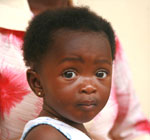September 2009
New research on extending antiretroviral (ARV) prophylaxis through six months of breastfeeding shows great promise for the prevention of mother-to-child transmission of HIV. In July, researchers announced findings from three highly anticipated randomized, controlled trials at the International AIDS Society Conference (IAS) in Cape Town, South Africa. The results added to a significant body of evidence showing that that giving ARV prophylaxis to infants or Highly Active Antiretroviral Therapy (HAART) to women who do not qualify for treatment during breastfeeding can significantly reduce transmission of HIV to infants.
The findings are significant for HIV-positive mothers who are faced with making difficult decisions about the safest way to feed their babies. Mothers may choose to avoid breastfeeding or stop early to avoid passing the virus through breastmilk, yet the danger of common diseases such as diarrhea and pneumonia, malnutrition, and infant and young child deaths associated with formula feeding is well known. If giving HAART to women who do not qualify for treatment can greatly reduce the HIV transmission risk of breastfeeding, more infants and children of HIV-positive mothers will be able to benefit from the health and nutrition benefits of breastfeeding.
According to Tim Quick, Senior Technical Advisor for HIV and Nutrition and Co-chair of the US President’s Emergency Plan for AIDS Relief Food and Nutrition Technical Working Group at the US Agency for International Development’s Office of HIV/AIDS, the new research means that more HIV-positive mothers may choose to breastfeed their babies and breastfeed for longer periods—ensuring that they get the nutrients they need to prevent malnutrition and infections.
“As long as there is still a risk of transmission through breastfeeding, we will continue to support mothers to make informed choices about infant feeding and help them balance the risks of breastfeeding and formula feeding,” said Quick. “These new findings may dramatically shift that balance in favor of breastfeeding.”
The current World Health Organization (WHO) HIV treatment guidelines recommend that stage one and two HIV-positive people, including pregnant women, begin ARV treatment if their CD4 cell count is less than 200 cells/μL. Later in the year, a WHO expert committee will meet to consider the available evidence on treatment for pregnant and breastfeeding women with higher CD4 counts and consider updating current guidelines to support temporary administration of ARVs to pregnant and lactating women who do not qualify for treatment.
As WHO considers how the new evidence should impact international recommendations, it will also consider the limitations of the evidence that leave many unanswered questions. The long-term health effects of giving HAART to women who do not qualify for treatment and infants are still unclear. Moreover, the feasibility of ensuring drug adherence among a population that looks and feels healthy is uncertain. And while these studies only provided drugs through six months, many women are unable to meet AFASS criteria (acceptable, feasible, affordable, sustainable, and safe) to stop breastfeeding until much later, so the efficacy and safety of continuing prophylaxis through the entire breastfeeding period is an urgent research need. The cost and human resources implications of providing ARVs to a much bigger population must also be modeled. Effectiveness trials are needed to determine the overall feasibility of implementing long-term prophylaxis in real-life settings.
Read summaries of the studies:
Date: Sep 29, 2009 | Category: Announcements
